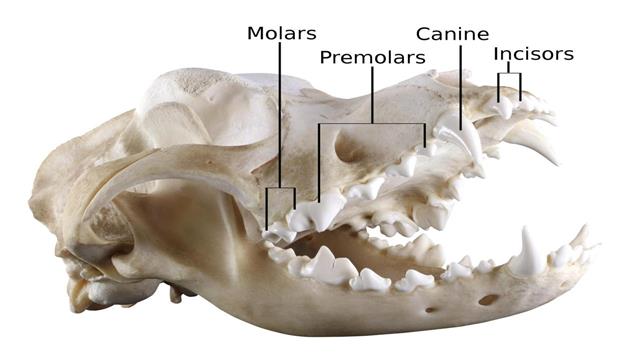Dogs have a total of 42 teeth! That’s a lot! However, one amusing fact about the dental anatomy of dogs is that the total number of milk teeth and the total number of permanent teeth are not the same.
They have only 28 milk teeth, and no puppy molars! You must have noticed that when your dog tugs at something playfully, he/she does so with the front portion of the jaw, but when you toss a stick or give him/her a bone, these things move to the rear portion of the jaw, where the chewing action takes place. This is due to the different functions of the different groups of teeth. The following paragraphs explain the two stages of dental development in dogs, as well as their dental anatomy.
Just like humans, dogs too have milk teeth before getting their permanent ones. These are also called deciduous teeth, puppy teeth, or baby teeth. When pups are born, they do not have any teeth. The deciduous teeth erupt through the gums when the pups are about 3 weeks of age, and this growth is usually complete by 4 months of age. The total number of deciduous teeth is 28―14 each in the upper and lower jaw.
After all your pup’s baby teeth have grown out, they will begin to be replaced by the permanent ones, after roughly 4 months of age. In the 4 months before they erupt, permanent teeth begin developing above the deciduous teeth, under the gums. When they grow big enough, they begin putting pressure on the roots of the baby teeth, thus bringing about the process of resorbing the roots. Once the roots are completely resorbed and have disappeared, the permanent teeth push down on the crown of the baby teeth that is left behind, and erupt.
It is during this time that your dog will undergo the teething process, when he/she will want to chew on anything in sight, owing to the discomfort of the growing teeth. At such times, you should give your dog toys to chew on, but make sure that he/she knows which items are off-limits in this department. Otherwise, your shoes, other household items, wires, or furniture may become the victims of your dog’s chewing urges. Consult your vet and get your dog the appropriate chew toys to redirect his/her attention from other things.
Deciduous and permanent teeth are the two stages of dental development in dogs. Now let’s see the dental anatomy of dogs, and what it comprises. Dogs’ teeth are categorized into four classes or types, viz., incisors, canines, premolars, and molars.

Incisors are the teeth that are present right in the front, on both the upper and the lower jaw. There are a total of 12 incisors, 6 each on either jaw, and they are small and sharp. They may not all be uniform in size, and may also vary in number. The two central incisors usually remain smaller in size than the others. The main functions of these teeth include chewing or nibbling on food, picking up objects, pulling something (like if you and your dog are playing tug-of-war, or when pups hold their own leash and pull you with it), or even for scratching purposes (if your dog has an itch or is grooming him/herself. Do check for fleas or ticks if the scratching is too frequent).
Canines are also called fangs, and are quite well-known because of dogs and vampire movies. These teeth are long and pointed, and are immediately next to the incisors. There are 2 canines each on the upper and lower jaws, one each on either side of the incisors. Thus, the right and left sides of the jaw have one upper and one lower canine each. The upper canines lock behind the lower ones. This is known as a scissor bite. The function of these teeth is to grab and tear. If your dog is fighting with another dog or is playing a game of fetch with you, then the canines are used to bite the ball or the other dog. Deciduous teeth include four 4 canines and 12 incisors.

These are the wide, flat, and pointed teeth that are situated behind the canines. The function of the premolars is chewing, tearing, and biting. Dogs chew their food using their premolars. You may even notice that if you throw a stick for your dog to fetch, then he/she will hold the stick at the side of the mouth in the premolars. Permanent teeth consist of 16 premolars―8 on either jaw and 4 on either side of each jaw. Deciduous teeth consist 12 premolars―6 on each jaw, and 3 on either side of each jaw. The very first tooth in this group is absent in puppy teeth.
Molars are bigger than premolars, and perform the main function of chewing hard things like bones or dog biscuits. They are a bit sharper than premolars as well. The total number of molars that a dog possesses is 10. There are 6 on the lower jaw―3 on each side, and 4 on the upper jaw―2 on each side. Puppies do not have any molars. Deciduous molars do not exist. They only grow as permanent teeth.





